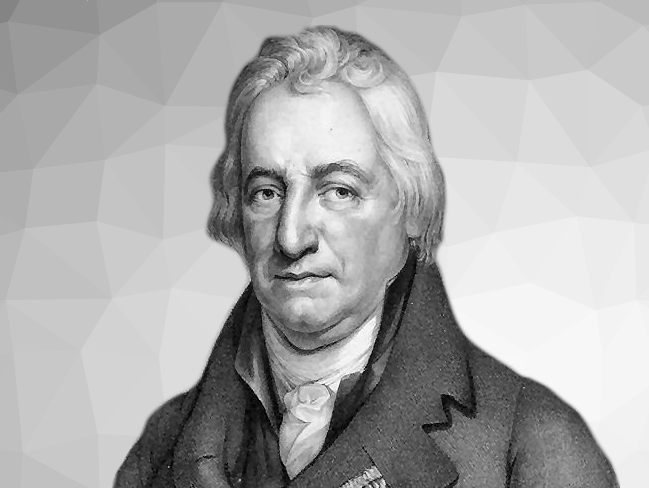Claude Louis Berthollet was born in Talloires in today’s France (then part of the Duchy of Savoy), on December 9, 1748. He made a broad range of contributions to chemistry: Berthollet is well-known for his work on modern nomenclature in chemistry. He also first determined the elemental composition of ammonia and worked on chemical equilibria, as well as on dyes and bleaches.
Berthollet first studied medicine at the University of Turin, Italy. In 1772, he settled in Paris, France, to continue his education. He studied chemistry at the University of Paris. For some time, Berthollet served as a private physician in the household of Louis Philippe I, the Duke of Orleans. The Duke provided Berthollet with a laboratory, where he could continue his studies.
Nomenclature, Dyes, and Bleach
In 1779, Berthollet defended his doctorate thesis, which was concerned with mercury passing into milk (De
lacte animalium medicamenlose). He first determined the elemental composition of ammonia in 1785 [2]. Berthollet worked on chemical nomenclature with Louis Bernard Guyton de Morveau, Antoine Laurent de Lavoisier, and Antoine François de Fourcroy [1]. Their work served as the basis of modern nomenclature. The precise contribution of Berthollet to this work is unknown.
In 1784, Berthollet took up the Directorship of the Gobelin dyeworks and tapestry factory in Paris. Here, he worked on dyes. His results were published in 1791 as Éléments de l’art de la teinture and served as a valuable source of information for dyers [3]. In 1789, Berthollet found that chlorine or hypochlorite can be used as bleach, which started a new bleaching industry.
Chlorate, Expeditions, and Equilibria
In 1788, Berthollet discovered the first chlorate, potassium chlorate [4]. He introduced elemental chlorine to an aqueous potassium hydroxide (KOH) solution and then evaporated it. With this approach, he obtained potassium chlorate (KClO3). He discovered that potassium chlorate exploded very easily in mixtures with carbon and saw an opportunity to improve on the recipe for gunpowder by replacing potassium nitrate with potassium chlorate [5,6]. Experiments on this substitution by Berthollet’s colleague Antoine Laurent de Lavoisier, however, led to an lethal explosion and the idea was put aside [4].
In 1798, when Napoleon went to Egypt, Berthollet joined the expedition as part of a corps of scientists. He returned to France in 1799, where he served as leading chemist at the Institut de France in Paris and established a private laboratory on his country estate in Arcueil, near Paris.
Berthollet made important observations on some of the characteristics of a chemical equilibrium. He published works on chemical “affinities” and chemical equilibria, Recherches sur le lois de l’affinité and Essai de statique chimique, in 1801 and 1803, respectively [7,8]. Claude Louis Berthollet died in Arcueil, France, on November 6, 1822.
Claude Louis Berthollet is the answer to Guess the Chemist (131).
References
[1] L. B. Guyton de Morveau, A. Lavoisier, C. L. Bertholet, A. de Fourcroy, A Dictionary of the New Chymical Nomenclature, James St. John, London, UK, 1788.
[2] C. L. Berthollet, Analyse de l’alkali volatil, Mémoires de l’Académie Royale des Sciences, 1785, 316–326.
[3] C. L. Berthollet, Éléments de l’art de la teinture, Firmin Didot, Paris, 1791.
[4] K. Roth, Chlorates: Tragic Incidents and Life-Saving Applications – Part 2, ChemistryViews 2022. https://doi.org/10.1002/chemv.202200097
[5] F. Seel, Geschichte und Chemie des Schwarzpulvers. Le charbon fait la poudre, Chem. Unserer Zeit 1988, 22, 9–16. https://doi.org/10.1002/ciuz.19880220103
[6] K. W. Böddeker, Zur Kulturgeschichte der Explosivstoffe: Konstruktiv, destruktiv, Chem. Unserer Zeit 2001, 35, 382–388. https://doi.org/10.1002/1521-3781(200112)35:6<382::AID-CIUZ382>3.0.CO;2-N
[7] C. L. Berthollet, Recherches sur le lois de l’affinité, Baudouin, 1801.
[8] C. L. Berthollet, Essai de statique chimique, Firmin Didot, Paris, 1803.
Sources
- P. Lemay, R. E. Oesper, Claude Louis Berthollet (1748–1822), J. Chem. Educ. 1946, 23, 158. https://doi.org/10.1021/ed023p158
- W. B. Ashworth, Jr., Scientist of the Day: Claude-Louis Berthollet, www.lindahall.org, 2021. (accessed November 3, 2002)
Also of Interest
-
C. Goedecke, 225th Anniversary: Death of Antoine Lavoisier, ChemistryViews 2019. https://doi.org/10.1002/chemv.201900047




